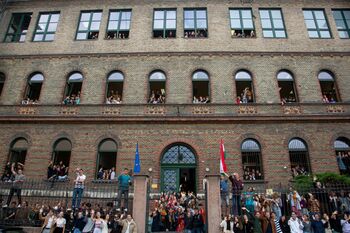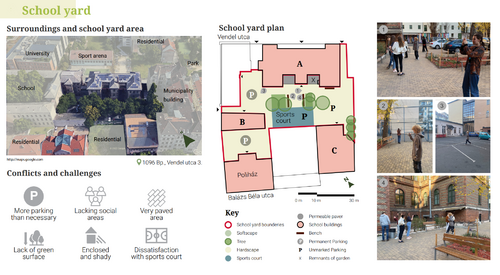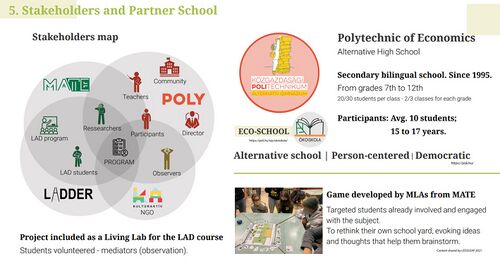LED2LEAP 2022 - Budapest Team: Difference between revisions
| Line 41: | Line 41: | ||
|width=880px }} | |width=880px }} | ||
Polytechnic of Economics is an alternative bilingual school, with pedagogical objectives related to alternative pedagogical movements, and continuously integrating modern pedagogical methodology into the daily teaching practice: cooperation, development of creativity, use of modern IT and communication tools, project work, extracurricular educational programs, and activities-based learning. It is also a person-centered school, meaning that the learner is at focus, having an integrative and personal character, offering opportunities to develop the students’ personalities. | Polytechnic of Economics is an alternative bilingual high school, with pedagogical objectives related to alternative pedagogical movements, and continuously integrating modern pedagogical methodology into the daily teaching practice: cooperation, development of creativity, use of modern IT and communication tools, project work, extracurricular educational programs, and activities-based learning. It is also a person-centered school, meaning that the learner is at focus, having an integrative and personal character, offering opportunities to develop the students’ personalities. | ||
= Phase A: Mapping Your Community = | = Phase A: Mapping Your Community = | ||
== Welcome to Your Community and Their Landscape == | == Welcome to Your Community and Their Landscape == | ||
| Line 57: | Line 57: | ||
== Groups of Actors and Stakeholders in Your Community == | == Groups of Actors and Stakeholders in Your Community == | ||
<gallery widths="500" heights="300" perrow="1"> | |||
File:POLYLADDER2023-01-02 040956.jpg | |||
<gallery | |||
File: | |||
</gallery> | </gallery> | ||
Revision as of 20:26, 3 January 2023
>>>back to working groups overview
For help with editing this Wiki page use this link.
For more details on assignments and key readings please use this link.
Landscape Democracy Rationale
An effective tool for determining the future of the natural environment and its resources is the improvement of environmental education in schools. To achieve such, more connection between the students and the landscape in which they belong, in this case the schoolyard, is an important first step. To accomplish this aim the Design-based Learning (DBL) methodology, or learning-by-doing, and the set of skills associated with landscape architecture (LA) can be particularly helpful.
How can a program Designed for a specific community, applying concepts of DBL and LA, help in achieving a more involved student community towards their schoolyard?
Location and Scope
Polytechnic of Economics is an alternative bilingual high school, with pedagogical objectives related to alternative pedagogical movements, and continuously integrating modern pedagogical methodology into the daily teaching practice: cooperation, development of creativity, use of modern IT and communication tools, project work, extracurricular educational programs, and activities-based learning. It is also a person-centered school, meaning that the learner is at focus, having an integrative and personal character, offering opportunities to develop the students’ personalities.
Phase A: Mapping Your Community
Welcome to Your Community and Their Landscape
The building is in a very densely built area, being surrounded by a municipality building in the southeast, to which the car entrance and some parking take place inside the schoolyard, Semmelweis University is to the north of the school, to the west, polytechnic shares a wall with another school Leövey Klára Gimnázium, while the remaining borders are shared with residential buildings.
Within the school grounds, 4 different buildings are used for different functions, buildings A and Poliház are classrooms, building B is a woodwork and crafts workshop and building C is a PE center.
Within the schoolyard area, there are two assigned parking areas, but also, the area in front of building C and the sports court are used as parking. In the whole yard, there is a small area of soft scape surface, within which there are a few well-established tall trees, a few smaller and multibranched threes, and formal shrubs of about 1,5m tall.
Some smaller level plantations can be found in the few planters distributed around the yard, also present are the remnants of a rock garden, which is no longer being maintained. Due to its enclosed character, the yard is very shady and lacks social areas for the students, having some park benches distributed in the surroundings of building A, and play equipment and artistic displays are nowhere to be found.
In a visit to the school it was pointed out some of the dissatisfaction of the students and some of the changes being considered for the future of the yard by the school administration. Among the topics raised, there was the discussion about the sports court, which the students dislike the appearance, nicknaming it a cage; position, complaining it takes up a lot of open space of the yard; and the fact that it is also used as parking. When it comes to the parking, the administration itself agrees there are more parking areas than actually necessary, and there is a general agreement on the necessity to increase the green surface within the area.
Groups of Actors and Stakeholders in Your Community
Relationships Between Your Actors and Groups
- insert text here
- Addyouruniqueimagename.jpg
insert text here
- Addyouruniqueimagename.jpg
insert text here
- Addyouruniqueimagename.jpg
insert text here
Summary of Your Learnings from the Transnational Discussion Panel
- insert text here
Theory Reflection
- insert text here
References
- insert text here
Phase B: Democratic Landscape Analysis and Assessment
Your Name and title of your personal analysis
- Addyouruniqueimagename.jpg
insert text here
- Addyouruniqueimagename.jpg
insert text here
Your Name and title of your personal analysis
- Addyouruniqueimagename.jpg
insert text here
- Addyouruniqueimagename.jpg
insert text here
Your Name and title of your personal analysis
- Addyouruniqueimagename.jpg
insert text here
- Addyouruniqueimagename.jpg
insert text here
Your Name and title of your personal analysis
- Addyouruniqueimagename.jpg
insert text here
- Addyouruniqueimagename.jpg
insert text here
Your Name and title of your personal analysis
- Addyouruniqueimagename.jpg
insert text here
- Addyouruniqueimagename.jpg
insert text here
Phase C: Collaborative Visioning and Goal Setting
The Scene in Your Story of Visioning
- insert text here
- Addyouruniqueimagename.jpg
insert text here
- Addyouruniqueimagename.jpg
insert text here
- Addyouruniqueimagename.jpg
insert text here
The Actors in Your Story of Visioning
- insert text here
- Addyouruniqueimagename.jpg
insert text here
- Addyouruniqueimagename.jpg
insert text here
- Addyouruniqueimagename.jpg
insert text here
The Story of Visioning
- insert text here
- Addyouruniqueimagename.jpg
insert text here
- Addyouruniqueimagename.jpg
insert text here
- Addyouruniqueimagename.jpg
insert text here
Reflect on Your Story of Visioning
- insert text here
- Addyouruniqueimagename.jpg
insert text here
- Addyouruniqueimagename.jpg
insert text here
- Addyouruniqueimagename.jpg
insert text here
Phase D: Collaborative Design, Transformation and Planning
Your Prototyping Action
- insert text here
- Addyouruniqueimagename.jpg
insert text here
- Addyouruniqueimagename.jpg
insert text here
- Addyouruniqueimagename.jpg
insert text here
The Evolution of Your Prototyping Action
- insert text here
- Addyouruniqueimagename.jpg
insert text here
- Addyouruniqueimagename.jpg
insert text here
- Addyouruniqueimagename.jpg
insert text here
The Plan Behind Your Prototyping Action
- insert text here
- Addyouruniqueimagename.jpg
insert text here
- Addyouruniqueimagename.jpg
insert text here
- Addyouruniqueimagename.jpg
insert text here
The Realization of Your Prototyping Action
- insert text here
- Addyouruniqueimagename.jpg
insert text here
- Addyouruniqueimagename.jpg
insert text here
- Addyouruniqueimagename.jpg
insert text here
Reflect on Your Prototyping Action
- insert text here
- Addyouruniqueimagename.jpg
insert text here
- Addyouruniqueimagename.jpg
insert text here
- Addyouruniqueimagename.jpg
insert text here
Phase E: Collaborative Evaluation and Future Agendas
Collaborative Evaluation and Landscape Democracy Reflection
- insert text here
- Addyouruniqueimagename.jpg
insert text here
- Addyouruniqueimagename.jpg
insert text here
- Addyouruniqueimagename.jpg
insert text here
The Actors in your Collaborative Evaluation
- insert text here
- Addyouruniqueimagename.jpg
insert text here
- Addyouruniqueimagename.jpg
insert text here
- Addyouruniqueimagename.jpg
insert text here
Reflection on the Online Seminar
- insert text here
- Addyouruniqueimagename.jpg
insert text here
- Addyouruniqueimagename.jpg
insert text here
- Addyouruniqueimagename.jpg
insert text here
Reflection on your Living Lab Process
- insert text here
- Addyouruniqueimagename.jpg
insert text here
- Addyouruniqueimagename.jpg
insert text here
- Addyouruniqueimagename.jpg
insert text here
Your Living Lab Code of Conduct
- insert text here
- Addyouruniqueimagename.jpg
insert text here
- Addyouruniqueimagename.jpg
insert text here
- Addyouruniqueimagename.jpg
insert text here
Process Reflection
- insert text here


